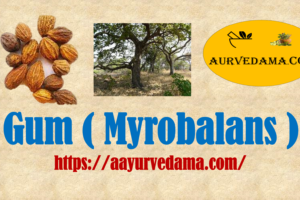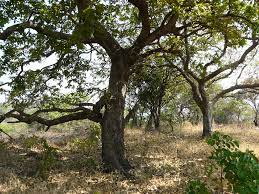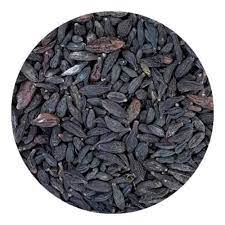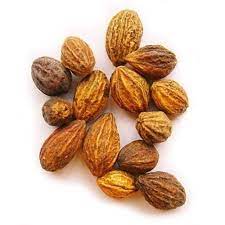Gum ( Myrobalans )
Classical classification of Gum ( Myrobalans )
1 Division: Magnoliophyta
2 Genus: Magnoliopsida
3 Class: Myrtales
4 Family: Combretaceae
6 Caste: Terminalia
7 Organism: T. chebula

Gum ( Myrobalans ) fruits
Gum (English: Myrobalans; Latin: Terminalia chebula) is a medicinal plant native to South Asia, Southeast Asia, and Yunnan Province in the People’s Republic of China. The gum is curative and curative. It has an important place in medicine and health enhancing liquid. According to folk tales, once Indra was drinking nectar and some drops of it spilled on the earth. Where that drop was spilled (from that drop) gum was produced. 2 thousand m from sea level. Gum trees are found all over India in upland soils.
Description of the Gum ( Myrobalans )
The gum is called “Haritaki”. Gum trees 25 to 30 m. They grow tall. The tree is deciduous, spreading and perennial. Its wood is very hard. Trunk height is 7 to 10 m. (Medium land) 24 to 30 m. (Fertile land) The bark of the trunk is gray in color with numerous incisions. Leaves 10 to 30 cm. I. Long, pointed, leaf veins are 6 to 8 and are opposite to each other. The leaves are connate at the ends. Young leaves have hairs.

tree
Flowers – come in summer and color is white yellowish. They are in the axils of branches and leaves. New flowers are fragrant while old flowers have a strong smell.
Fruit – length usually 3 to 6 cm. I. The color of young fruits is green and the color of ripe fruits is yellowish gray. Shape oblong circular, each fruit contains one seed, several varieties of gum can be identified from the fruit. The seed is long and hard.
After the tree is about 10 years old, it starts bearing fruits. The immature fruits of 2 to 2.5 months are called baby gums.
Gum ( Myrobalans ) type
There are seven varieties of gum based on the color of the fruit, 1) Vijaya, 2) Rohini, 3) Putana, 4) Amrita, 5) Abhaya, 6) Jeevanti and 7) Chetaki.
Baby gum – the fruit that falls off automatically before the pulp is formed in the fruit, is of special use in medicine. It is widely used in small children.

Baby Gum ( Myrobalans )
Chambhari Hirda – The small unripe fruit of the gum called Chambhari Hirda is used for making leather. Export in bulk.
Survari Gum – The fully ripe fruit of the gum is Survari, with many medicinal uses.
Colored gum – It is used for coloring.
This plant has many names in Sanskrit language :-
Haritaki – Arising in Shankara’s house (Himalayas), vanquishes all diseases.
Hemvati, Himja – originating in the Himalayas.
Abhaya – Regular consumption of gum leaves no fear of disease.
Kayastha – body healthy, fattening.
pachni – digestive.
prapathya–sanctifying.
Pramatha – Eradicator of diseases.
shreyasi – superior.
pranada – the giver of life.
Importance
Green is the mother of mankind.
Perhaps Mother Godrastha Haritaki.
In this verse, the gum is compared to a mother. The gum is motherly loving and benevolent. Mother also sometimes gets angry with her children but does not cause any kind of trouble when the gum is consumed.

Seeds
Also
Yasya nasti mata, tasya mata haritaki:
Of course –
There is a saying in Sanskrit that motherless babies have mother gums. It gives an idea of its use. The fruit of this tree is one of the Triphala family.
Another Sanskrit verse that emphasizes the importance of the gum-
Harin Haritki Chaiva Gayatri day day day.
Moksharogyatap: Kamashchintayed bhakshayejpet ॥
of course-
One who desires salvation should meditate on Vishnu every day, one who desires health should consume gum every day and one who desires tapas should chant Gayatri.
Medicinal uses
There are five juices in the gum: sweet, sour, bitter, pungent and astringent. Not just salty juice. Its sweet, pungent and astringent juices destroy pitta dosha. Bitter, pungent and astringent rasas relieve Kapha dosha. While sweet and sour juices remove vata dosha.
The gingiva has the qualities of Laghu and Ruksha. Laghu means yoga which creates lightness in the body, brings enthusiasm. Generally, Lagha guna fluids reduce the increased kapha dosha in the body. Medicines of this guna act on those places in the body where mala is produced, the fruits of the gum remove mala dosha. Ruksha means roughness, hardness in the body. This guna increases the amount of vata dosha in the body, decreases the amount of kapha dosha. It is very useful in diseases like diabetes.
Indigestion, diarrhoea, hemorrhoids, loss of appetite, excessive sweating, eye disease, obesity, indigestion, acidity, inflammation, biliousness, leprosy, eczema, gallstones, rheumatism, stomach disease, panduro, kidney stone, hiccups, vomiting, etc. It has been considered as an important medicine. Survari gum is useful in diseases of dysentery. It is good for diarrhoea, constipation and looseness of bowels. In Arsha (root disease) disease it is given along with gum pain and its quath is given in Raktarshan. If the arsha is swollen and painful, the gum is raised and applied.
Although the gum( Myrobalans ) is versatile, it should be used with different substances according to the season:
Spring i.e. Chaitra, Vaishakh with Madha,
Summer season means Jyeshtha, with jaggery in Ashadh,
Rainy season i.e. Shravan, along with Saindhav Mitha in Bhadrapada,
Autumn means Ashwin, along with sugar in Kartik,
Hemanta Ritu means Margashirsha, along with Sunthi in Paush, and
Shishir Ritu Magha, with Pimpli in Phalgun. Indigestion, diarrhoea, fall of intestines, hemorrhoids, loss of appetite, profuse sweating, eye disease, obesity, dyspepsia, acidity, inflammation, biliousness, leprosy, eczema, gallstones, rheumatism, stomach disease, gonorrhoea, kidney stone. , hiccups, vomiting, etc. Gum has been considered as an important medicine for many disorders. Survari gum is useful in diseases of dysentery. It is good for diarrhoea, constipation and looseness of bowels. In Arsha (root disease) disease it is given along with gum pain and its quath is given in Raktarshan. If the arsha is swollen and painful, the gum is raised and applied.
The bark of the gum plant is dark brown and fissured, the young parts are reddish or silvery, and the luscious leaves are almost, opposite, ovate, rounded at the base (10–20 cm), deciduous February-March, new leaves appear at the tips of the branches in April. The flowers are bisexual, smoky white or yellowish green and appear in May-June at the apex on a peduncle or on a panicle.
Source : Wikipediya
Read More –
Faq –
1 The gum is called “Haritaki”. Is it wrong or right ?
2 What is the length of gum fruit ?
3 What should be used with gum in summer season ?